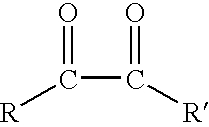Anticancer agents based on prevention of protein prenylation
a technology of anticancer agents and prenylation, which is applied in the direction of transferases, peptide/protein ingredients, instruments, etc., can solve the problems of unrestrained cell division of cancer cells, and achieve the effects of reducing enzyme activity, preventing drug resistance, and increasing tumor cell killing
- Summary
- Abstract
- Description
- Claims
- Application Information
AI Technical Summary
Benefits of technology
Problems solved by technology
Method used
Image
Examples
example 2
In the same manner as Example 1, compound 2-oxododecanal was tested for inactivation of FTase in the fluorescence assay system described, except as noted below. Final concentrations in the incubation mixture were 5, 10, and 35 mM 2-oxododecanal. A stock solution of 2-oxododecanal dissolved in dimethyl sulfoxide (DMSO) was employed. The final concentration of DMSO in the incubation mixture (as well as the control) was 5%. The results are shown in FIG. 4. It was found that 2-oxododecanal rapidly inactivated FTase, probably by reaction with one or both of the active site arginine residues. This would block access of one or both of the substrates (FPP and / or the peptide substitute for Ras protein) and / or block the catalytic function of one or both of the arginine residues, resulting in inactivation of the enzyme.
example 3
In the same manner as EXAMPLE 1, compound 5,9-dimethyl-8-decene-2,3-dione was tested for inactivation of FTase in the fluorescence assay system described, except as noted below. A stock solution of 5,9-dimethyl-8-decene-2,3-dione in 5% DMSO was employed. The final concentration of DMSO in the incubation mixture (as well as the control) was 4.6%. FTase was at 15 nM, and the Microcon concentration step was omitted. It was found that 5,9-dimethyl-8-decene-2,3-dione rapidly inactivated FTase. After 30 minutes of incubation with 17, 68, or 171 .mu.M 5,9-dimethyl-8-decene-2,3-dione, FTase activity was reduced to 38%, 18%, or 16% of the initial control value, respectively.
example 4
In the same manner as EXAMPLE 1, dehydroascorbic acid 6-palmitate was tested for inactivation of FTase in the fluorescence assay system described, except as noted below. A stock solution of dehydroascorbic acid 6-palmitate in 2% DMSO in 5 mM sodium acetate, pH 3.9, was employed. The final concentration of DMSO in the incubation mixture (as well as the control) was 0.46%. FTase was at 15 nM, and the Microcon concentration step was omitted. It was found that dehydroascorbic acid 6-palmitate rapidly inactivated FTase. After 30 minutes of incubation with 7, 28, or 141 .mu.M dehydroascorbic acid 6-palmitate, FTase activity was reduced to 75%, 34%, or 22% of the initial control value, respectively.
PUM
| Property | Measurement | Unit |
|---|---|---|
| pH | aaaaa | aaaaa |
| pH | aaaaa | aaaaa |
| hydrophobic | aaaaa | aaaaa |
Abstract
Description
Claims
Application Information
 Login to View More
Login to View More - R&D
- Intellectual Property
- Life Sciences
- Materials
- Tech Scout
- Unparalleled Data Quality
- Higher Quality Content
- 60% Fewer Hallucinations
Browse by: Latest US Patents, China's latest patents, Technical Efficacy Thesaurus, Application Domain, Technology Topic, Popular Technical Reports.
© 2025 PatSnap. All rights reserved.Legal|Privacy policy|Modern Slavery Act Transparency Statement|Sitemap|About US| Contact US: help@patsnap.com



